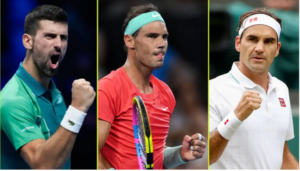It’s 2018. Stefanos Tsitsipas, a Greek 20-year-old who is a bright future prospect, won the NextGen Finals, a competition for up-and-coming tennis players. In less than a year, he emerges victorious from the ATP World Tour Finals, the ultimate tennis title following a Grand Slam, and becomes the youngest champion since 2001. The titans of the game start to look forward to Tsitsipas’s arrival as the men’s tennis game’s heir apparent and predict that he will usher in a new era.In 2023, four years after this victory, Tsitsipas’s career presents a radically different picture from what many had anticipated. At twenty-five, he and other players in a similar situation, like Andrey Rublev and Alexander Zverev, are no longer seen as a threat to the tennis throne in the same way that he once was, and his chances of winning a slam are dwindling. Instead, the “next generation” of talent is taking their place. The upcoming generation of teenagers and twenty-year-olds are scrappy, unrefined, and characterised by an overwhelming desire to succeed. They are still in the stage where their lack of experience is eclipsed by their obsession with proving themselves. Additionally, they are quicker, exhibit unflinching bravery on the court, and have an abundance of ,There is yet possibility to be realised. And these athletes are currently being hailed as the tennis world’s heirs.
In actuality, Tsitsipas’s best opportunity to win a slam has already passed. The harsh reality of the tennis business has set in, and he is no longer a starlet himself, boosted by thoughts of grand slam victories that were unattainable just four years ago. Every year he missed out on realising his dream of a grand slam, it would be a year closer for someone younger. The issue is not exclusive to Tsitsipas; Eugenie Bouchard, who was twenty when she made it to the Wimbledon finals, has lost form and is currently outside the top 200. At twenty-two years old, Madison Keys advanced to the 2017 US Open final after ranking in the top fifty as an eighteen-year-old, however she suffered a stark drop in performance over the next few years, which she only saw end in 2023.
Tsitsipas appears to have realised that his odds of realising the goal he has spent his entire life pursuing: “Roughly speaking, there was a gap between 2018 and 2020 before Carlos Alcaraz, Holger Rune, and Jannik Sinner.” Then I was the centre of attention.We’re not as young anymore, thus the situation has changed. Young athletes are fearless, extremely vivacious, and thirsty.A world number one and a grand slam title? Though it’s not everything on my mind, I think about it frequently. He is honest enough to admit that his future is uncertain, but he also expresses remorse that he will never be able to fulfil the dreams he has spent his entire life pursuing.
It is not accidental to have early highs of achievement followed by years of falling short of expectations; a number of variables might contribute to this dreadful experience. It is impossible to overstate how tumultuous junior tennis is; it is a time when form varies and mental and physical strength are growing, so success here is not a dependable predictor of success elsewhere. Acclimating to the world of sports is also quite difficult because it requires constant travel, which makes it difficult to settle down. Many athletes blame burnout for their career downturn.
As demonstrated by Hyeon Chung, who made it to the 2018 Australian Open semifinals and was likewise hailed for greatness before experiencing persistent injury problems, injuries are also widespread. Mental challenges also play a role, particularly when balancing the demands of achieving expectations with the impact of personal problems, celebrity, and the pernicious attitudes of the media. This combination of difficulties may cause a player to understand that their deeply ingrained childhood dream of winning the greatest tennis titles will not come true—a fate that has befallen countless players and will continue to do so for a great many more. The tennis scene is brutal; young players are always rising through the ranks to replace players such as Tsitsipas, who did the same when he was twenty years old. When athletes hit their early twenties, they almost perfectly complete the circle, reverting to their former selves as players and finding it difficult to have the same kind of impression. Though there are glimmer of hope still for Tsitsipas. With only ten years left in his career at the age of 25, he has many opportunities to realise his goals. He showed promise for long runs by making it to a slam final in 2023. Furthermore, at ages older than Tsitsipas, Thiem, Cilic, and Halep have all recently attained the highest level of tennis. Young players in tennis are caught in a vicious cycle, but its curse can still be broken – whether Tsitsipas joins this illustrious list is dubious but not entirely out of the question.








